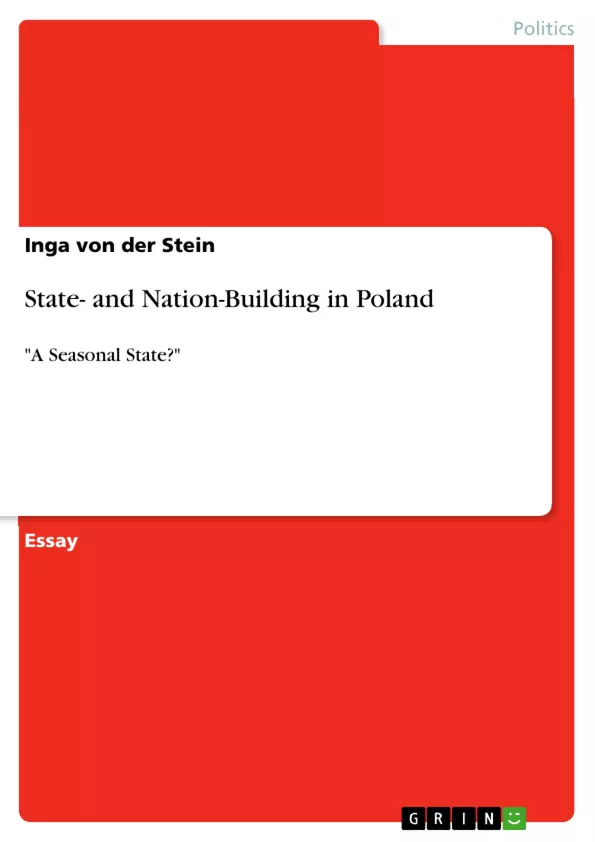"Saisonstaat” (seasonal state) - this was the pejorative name Prussian historians labelled Poland with in the 18th century (Davies, 2005, pp. 24, 324). They did so in the face of the partitions of Poland, which resulted in Poland completely vanishing off the map (Davies, 2005, p. 386).
But why was Poland seen merely as an instrument for Prussia and Russia in striving for hegemony? (Biskupski, 2000, p. 22) This question is difficult to answer and already gives a hint to the complexity of the process of state- and nation-building in Poland, which deviates in many aspects from the Western European countries.
To provide a foundation for the concepts that this paper is based on, one needs to define the terms of both nation and state. According to Smith, a nation is more than only an ethnic group but a cultural- political community, living in an area of settlement and sharing a common heritage, culture and law (Smith, 1995, p. 57). The concept of a state applied derives from Roberts. To him, a state is characterized by “the presence of supreme authority, ruling over a defined territory, who is recognized as having power to make decisions in matters of government […]” (Roberts, 1979, p. 32).
Taking these definitions into consideration, this paper is divided into four sections, relating each of the different stages in the state- and nation-building process to one season of the year. This paper firstly examines the economic “spring” of Poland, the Piast dynasty, thereafter attention is laid on the Jagiellonian period, Poland’s “summer”, which is linked to the personal union of Poland and Lithuania. In the next section I analyze the “fall” of the Poland, which is characterized by the consolidation of the Nobility’s supremacy and the economic decay of the country. This is leading up to the last section of this paper, as well as the partitions which killed the Polish state, yet the nation was becoming more alive than ever.
My aim is to show that the state- and nation-building process of Poland was not destined to become “a country only for a season” as claimed by Prussian historians, though following a unique way, a nation state might have been successful by the beginning of the 19th century if it had not felt victim to the will of territorial expansion by its neighboring empires (Weinberg, 1996, page. 42).
To that end, several lines of a poem named “Sezony” (seasons) written by an anonymous Polish Poet form the frame.
Inhaltsverzeichnis (Table of Contents)
- 1 Introduction: A “Seasonal state”?
- 2 Poland's spring: a kingdom of fragmentation but economic augmentation (966-1385)
- 3 Poland's summer: The Jagiellons (1385-1569)
- 4 Poland's fall: The Republic of the Nobility (1569 – 1795)
- 5 Poland's winter: a dead state but a living nation (1795-?)
- 6 Conclusion: Poland's next spring?
Zielsetzung und Themenschwerpunkte (Objectives and Key Themes)
This paper aims to analyze the state- and nation-building process in Poland, focusing on the unique and complex path it took compared to Western European countries. It examines the different stages of development by relating them to seasons, with each section exploring a particular era.
- The Piast Dynasty and the economic "spring" of Poland
- The Jagiellonian period and Poland's "summer" marked by personal union with Lithuania
- The "fall" of Poland during the Republic of the Nobility, characterized by economic decay and the consolidation of noble power
- The aftermath of the partitions, leading to a "winter" for the Polish state but a resurgence of national consciousness
- The impact of the Church on state and nation-building
Zusammenfassung der Kapitel (Chapter Summaries)
The first chapter introduces the concept of a "seasonal state" and examines the historical context of Poland's partitions, which led to its temporary disappearance from the map. It also defines the terms "nation" and "state" as key concepts for understanding the Polish experience.
The second chapter focuses on Poland's "spring" under the Piast Dynasty, highlighting the early stages of state formation. It discusses the myth of Piast as a foundational narrative and analyzes the economic and cultural factors that contributed to the rise of Poland. The chapter explores the complexities of Poland's relationship with the Holy Roman Empire and the Church, while also discussing the challenges of fragmentation among Piast princes.
Schlüsselwörter (Keywords)
Key terms and concepts central to this work include: state- and nation-building, Polish history, Piast Dynasty, Jagiellonian period, Republic of the Nobility, partitions of Poland, "seasonal state," "twin oracles" of Christianity, fragmentation, economic development, cultural identity, the Church, and the myth of Piast.
- Quote paper
- Inga von der Stein (Author), 2013, State- and Nation-Building in Poland, Munich, GRIN Verlag, https://www.grin.com/document/267940



